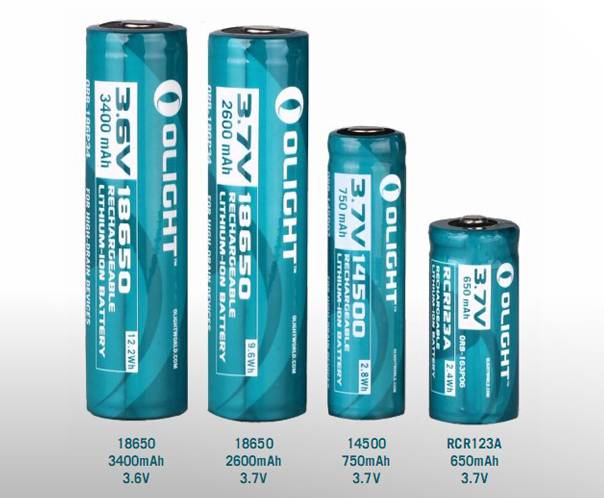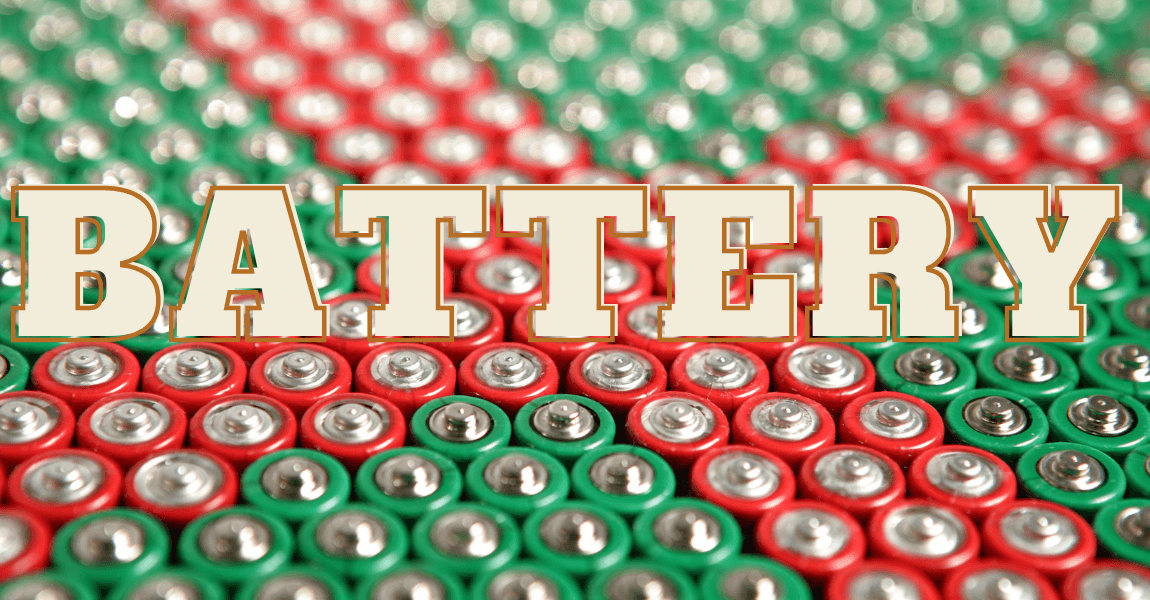The power consumption of current LED flashlights is generally not small. From the perspective of economy and environmental protection, for flashlights, it is recommended to use rechargeable batteries as the main energy storage device, and non-rechargeable batteries as backup options. For enthusiasts, the most ideal battery is a rechargeable lithium battery, which has high energy density, high discharge voltage, no need to consider memory effect, economy, environmental protection, etc., and has various advantages.
In the beginning, We will give you a brief introduction to the basic knowledge of lithium batteries, and then I will post olight commonly used lithium batteries. There are many types of lithium batteries in terms of packaging, materials, and shapes. When we buy flashlights, we always see the use of AAA, AA, CR123A, 14500, 16340, 18650, 26650, and other batteries, so what do these numbers represent?
AAA and AA here are No. 7 and No. 5 batteries, and the following numbers are actually the identification method of industrial lithium battery cells. They are composed of 5 digits. The first 2 digits are the battery diameter, and the three or four digits are marked. is the height of the battery in millimeters.
14500 is a lithium-ion battery with a diameter of 14mm and a height of 50mm. The size is the same as our common AA batteries. Only the voltage is different. AAA, AA, there are ordinary disposable alkaline batteries, there are also rechargeable Ni-MH batteries, the highest voltage is 1.6V. 14500, 16340, 18650, 26650 belong to lithium batteries, the highest voltage is 4.2V. CR123A is a one-time lithium battery, the size is the same as 16340, and the maximum voltage is 3V.

1. 10440 battery
The 10440 battery is a lithium battery with a diameter of 10mm and a height of 44mm. It is the same size as the "AAA battery" we often call it. The battery capacity is generally small, only a few hundred mAh. It is mainly used in mini electronic products. Such as flashlights, mini stereos, amplifiers, etc.
2. 14500 batteries
The 14500 battery is a lithium battery with a diameter of 14mm and a height of 50mm. This battery is generally 3.7V or 3.2V. The nominal capacity is relatively small, a bit larger than the 10440 battery, generally 1600mAh, with superior discharge performance and the most application field. The 14500 is also widely used, and the reason is very simple. Its volume is the same as that of an AA (No. 5) battery, and it can be put into a flashlight using AA batteries. Of course, it must be supported on the circuit. Mainly consumer electronics, such as wireless audio, electric toys, digital cameras, and so on.
3. 16340 battery
The 16340 battery is a lithium battery with a diameter of 16mm and a height of 34mm. This kind of battery has a shorter ruler height and a smaller capacity, so it can be used in strong light flashlights, LED flashlights, headlights, laser lights, lighting fixtures, etc. occur frequently.
4. 18650 battery
The 18650 battery is a lithium battery with a diameter of 18mm and a height of 65mm. Its biggest feature is that it has a very high energy density, almost reaching 170 Wh/kg. Therefore, this battery is a cost-effective battery. We usually often Most of what I see are this kind of battery, because it is a relatively mature lithium battery, and the system quality is stable in all aspects. It is widely used on occasions with a battery capacity of about 10 kWh, such as in mobile phones, laptops, and other small appliances.
5. 21700 battery
The 21700 battery is a lithium battery with a diameter of 21mm and a height of 70mm. Because its volume increases, the space utilization rate increases, and the energy density of the battery cell and the system can be improved. Its volume energy density is much higher than that of the 18650 battery. It is widely used in digital, electric vehicles, balance vehicles, solar energy lithium battery street lights, LED lights, power tools, etc.
Click here to view Olight's batteries.
6. CR123A battery
The CR123A battery is a non-rechargeable lithium battery, and its outstanding advantage is its high energy density. The 16340 battery has the same volume as the CR123A battery, but the process is different. The energy density of the CR123A can even reach 2.5 times that of the 16340 battery. In addition, its effective storage life is very long, even up to 10 years. Most of the S series in olight are equipped with CR123A batteries as standard and are compatible with 18650 batteries.
The flashlight with CR123A battery can obviously be very small in size, such as the olight S1R BATON, the barrel length is only 61 mm, the head diameter is only 21 mm, and the weight without battery is only 30 grams. It is very small, very light.
Usually, in addition to these general battery models above, there are some products that are specific batteries.
For example: Olight I5R uses a customized 1420mAh lithium-ion battery.
Discharge current and rate
The discharge current and rate of the lithium battery are also important indicators, which determine whether the battery is suitable for your flashlight. When purchasing a battery, you should first check whether the discharge capacity meets the requirements, and then consider the capacity. The discharge current is divided into continuous discharge and peak discharge. Continuous discharge means that the battery can be discharged at this current for a long time under a standard environment. The peak current is the current that the battery can withstand occasionally and instantaneously, and cannot be discharged at the peak current for a long time.
In addition to the discharge current, some battery parameter tables indicate the discharge rate, such as 5C and 10C, which means 5 times and 10 times. Discharge rate C number = battery capacity/1000, such as 3000mAH lithium battery, 5C is equal to 5*(3000/1000)=15A discharge current, 10C is 10*(3000/1000)=30A discharge current. Many people like to disassemble 18650 batteries from power banks and laptop batteries. It is not recommended to do so. These batteries are generally of capacity type unless you can measure the discharge performance of these batteries yourself.
About the battery with protective plate
There are many DIY flashlights and low-end brand flashlights that do not have built-in battery protection functions. They may accidentally discharge the battery power and cause the battery to be scrapped or affect its life. Some friends think of buying lithium batteries with built-in protection plates. This kind of lithium battery with a protective plate is actually a protective plate connected in series with the negative electrode. The internal resistance is particularly high, and it is not suitable for high-power discharge. Of course, except for the lithium battery with a protective plate customized by the brand manufacturer; Ordinary batteries are long, and some flashlights or chargers can't be put in at all. Here I do not recommend using a lithium battery with a protective plate on a strong light flashlight. If you are concerned about battery life, try to buy a flashlight with a low-voltage battery protection circuit.
About storage and maintenance
Lithium battery storage does not require high environmental requirements. It is not recommended to store it in a storage box in a cool and dry place for a long time. When the flashlight is not used for a long time, the battery should be taken out. Most flashlights will have a weak current consumption. If they are not used for a long time, the battery may be discharged and the battery life will be affected. It should also be noted that if the lithium battery is stored for a long time, the voltage should be kept around the rated voltage, that is, 3.7V. The long-term high-power and low-power storage of the lithium battery will affect the service life.
You can also click here to view the detailed knowledge of lithium batteries!





